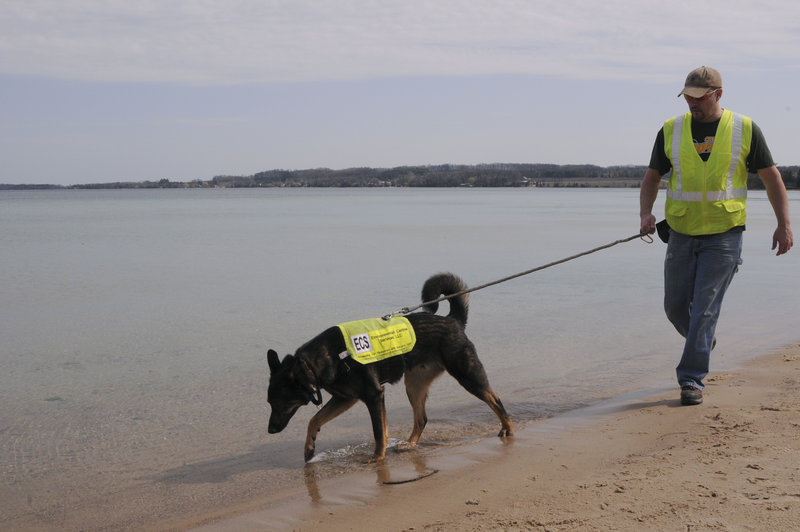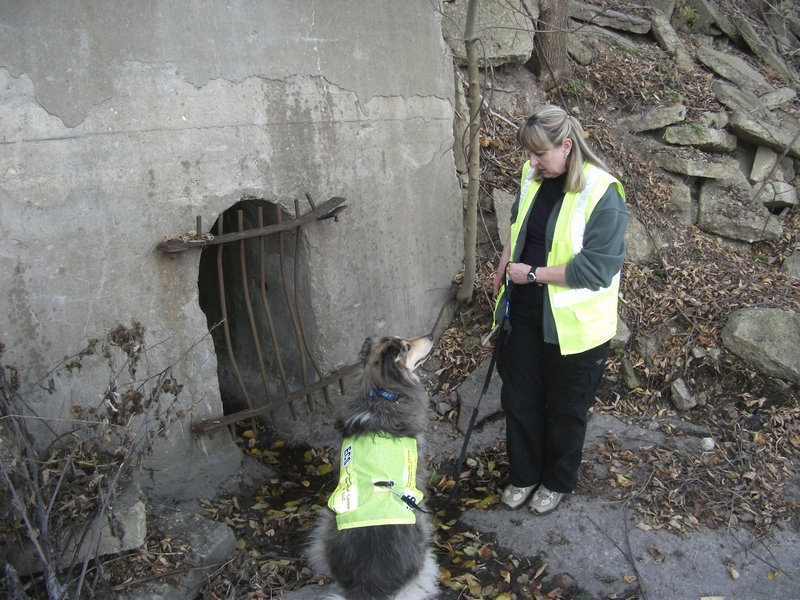It’s not an idea to pooh-pooh.
In fact, it seems so obvious that it’s hard to believe no one thought of it sooner: dogs sniffing for human waste.
They smell almost everything else that’s foul anyway. Might as well find a good use for the trait.
That’s exactly what a Michigan company has done. With a team of four “sniffers,” Scott and Karen Reynolds of Vermontville, Mich., started Environmental Canine Services in 2009 to offer a unique specialty: finding sources of human waste in water systems.
The Reynoldses and two male rescue dogs — a German shepherd mix named Sable and a rough-coated collie mix, Logan — are traveling halfway across the country to work this week in five communities from Portsmouth, N.H., to Portland. Two other dogs on their team are staying at home.
“Where there are issues of high bacteria,” the dogs “detect human sources of bacteria,” said Emily DiFranco, project manager with FB Environmental of Portsmouth. The consulting firm specializes in directing environmental planning and monitoring projects, including mapping and water projects, mostly for public-sector clients.
The firm calls on Environmental Canine Services for thorny issues — when humans can’t make scents of what’s gone wrong.
Both humans and dogs rely on their senses of sight, hearing and smell to interpret the data of the world around them. Most humans communicate first by hearing; dogs start by smelling.
“While a dog’s brain is only one-tenth the size of a human brain, the part that controls smell is 40 times larger than in humans,” says the Dog Breed Information group’s website. Depending on the breed, “a dog’s sense of smell is about 1,000 to 10 (million) times more sensitive than a human’s. A human has about 5 million scent glands, compared to a dog, who has anywhere from 125 million to 300 million.”
So in cases that defy humans’ ability to detect potential problems, a dog can be an expert detective.
Using a dog’s capacity to not only smell a specific thing, but also to distinguish it from any other stench, draws on the canine’s “natural instinct,” said Scott Reynolds. If the dog is trained to bring that natural ability to the fore, he said, “that’s when you see that focus.”
The idea to train dogs for this very particular job came almost by accident, when Reynolds, an engineer, was working for a firm in Lansing, Mich.
One day, his boss — who knew Reynolds had experience in training dogs for search and rescue — asked him, “Do you think you could train a dog to smell poop?”
“At first it was funny,” said Reynolds. “Then I thought, ‘Why not?’ Dogs are doing so many things, so many different things.”
To his surprise, he found “it had never been done,” he said. So he and his wife — who met at a dog-training class he was teaching — set out to find a method to train their dogs for a task that humans find unpalatable, and nearly impossible.
Sable was their first recruit from a rescue organization, because a video online showed him to be a dog with “fantastic drive, focus … and he’s not afraid of water,” Reynolds said.
All of their rescue dogs have proven to be excellent candidates for the job, Reynolds said. “They’re certainly capable of doing this,” he said.
The couple got wastewater samples from a treatment plant and essentially built a course of “manholes, catch basins, curb inlets and other pipe materials” in their backyard. Then they trained the dogs to “alert” to human fecal sewage.
Once the dogs get the hang of it, distraction scents are added — like cow manure — to help them narrow their olfactory focus. “It’s sort of a calibration thing now,” Reynolds said.
Municipalities tend to seek out the dogs’ skills when, for example, they have a problem in a storm drain system, a leaky septic system that is contaminating nearby water, or state or federal water monitoring that must be done on a regular basis.
“The sources for contamination problems can be costly (and) difficult to pinpoint,” said DiFranco, with FB Environmental. “It’s important to (determine) the source to clean it up.”
The charge for the dogs to find the source is $75 an hour, Reynolds said, while “the dogs are paid in kibble.”
Even when it’s clear that there’s a problem — for example, bacteria showing up in routine water testing of a beach, river, lake or tributary — “you can’t always clean it up. It’s tough; it’s difficult,” DiFranco said.
“A leaking septic system might only overflow at certain times of day,” or the evidence might remain “all underground,” she said. With their more sensitive and discriminating sense of smell, the dogs “narrow that down to a very limited area … and give these towns … a leg up” on taking care of the problem.
If humans have to do the job on their own, the task can take longer, it’s likely to be much more labor-intensive, and it may fail, because testing is on a “best-guess” basis.
The dogs are trained in much the same way as bomb- or drug-sniffing dogs, and already have demonstrated their skill in Michigan and California.
Portland accepted a proposal to have the dogs work along a portion of its stormwater system that has affected Capisic Brook at times, said Nicole Clegg, the city’s spokeswoman.
The brook is “an impaired stream” that the city has been working hard to improve, she said, so human fecal matter is the last thing that should make its way into that system.
“We saw an opportunity here,” Clegg said, to have the dogs accomplish with greater ease some work that would take much more human labor to detect and correct.
The dogs will make their way north, up the coast, starting their work in Portsmouth. Then they’ll get a whiff of potential problem areas in Kittery, Ogunquit and Old Orchard Beach before taking on Portland’s storm drains Thursday.
They will take a break from the work for a public demonstration day Tuesday, from 1 to 3 p.m. in the back parking lot of the Kittery Trading Post.
In Portland, the dogs will try to home in on sources of human waste in parts of the storm drain system, DiFranco said. “They’ll put their nose into a pipe” and, if there’s a problem, give a signal that their handlers have trained them to use, she said.
“One barks,” she said. “The other sits down. If they don’t detect anything, they just don’t give a signal.”
For most dog owners, a pet sitting or barking might not signal anything other than Milk-Bones-as-usual. Reynolds and his wife said their working-dogs-in-training pretty much show their owner-bosses what signal they want to use.
The Reynoldses use positive reinforcement in their training, supplementing it with a reward that is suited to the particular dog.
Sable, for example, wants only a squeaky tennis ball as his reward, and he gets one only when he has done his work successfully. Logan, on the other hand, “is very food-motivated,” Reynolds said.
The dogs’ health is paramount, he said. After each investigation, they are showered and their bodies — particularly their pads — are checked carefully for any injury, including superficial scratches.
“If we are not sure” an area is safe, Reynolds said — for example, it might have toxic industrial sewage — the dogs are not sent out on the job.
“They’re part of our family,” he said. “We have an emotional investment in them.”
Staff Writer North Cairn can be contacted at 791-6315 or at: ncairn@pressherald.com
Send questions/comments to the editors.




Comments are no longer available on this story